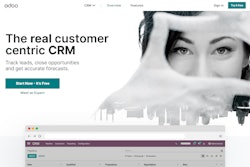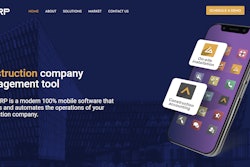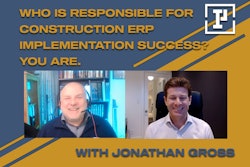
As merger and acquisition activity roils portions of the construction software space and tighter venture capital funding constrains others, Saint-Georges, Quebec-based Blackware Technologies has launched Atoom ERP, a new construction business software product built on the open source Odoo enterprise resource planning (ERP) platform.
This gives contractors the benefit of a broadly-used and robust enterprise suite—one that has received more research and development than could a construction-only solution—but with deep construction features and support from an industry-dedicated systems integration firm.
While Blackware is small now—with less than 20 employees at the time of our 2022 briefing calls—the Quebec City-area company plans to staff up to support this new construction ERP offering. Already, the company had a customer success team of four and was building out a network of reseller and referral partners to help drive contractors to the new enterprise software option.
“Every part of the business will grow,” Blackware Technologies CEO Guillaume Roy said. “We have made a switch to software as a service. When we did that, we had a big increase in terms of annual recurring revenue.”
Apart from serving as CEO and co-founder at Blackware, Roy has been a shareholder of a commercial and industrial construction materials company and sits on corporate boards in the regional construction space. Some of these companies according to Blackware sources have already adopted the Atoom ERP product Blackware is rolling out. One thing working in Blackware’s favor in the current financial climate is that they are not dependent on venture capital, which is constrained right now as the stock market slips.
“After Roy sold his earlier company, he created Blackware and we have been able to produce good financial results to finance ourselves with traditional banking,” Blackware Technologies Director of Customer Success Philippe Gagnon said. “We have been able to do accurate planning so the bankers trust us, and there is a good economic fit for them right now in technology.”
Blackware has secured between $1 and $2 million in bank loans and combined with organic revenue has a stable enough base to launch a product across North America.
The company has a small direct sales team, but is also ramping up a broader network of referral partners and resellers. As of our briefing, Blackware reported 10 companies using Atoom ERP in production but almost 25 in implementation on some modules while in production on others.
“We will go to market in part through suppliers of third-party services and independent software vendors, (ISVs),” Gagnon said. “Most of these partners will function as referral partners. What will get us referred by law firms and accounting firms around Quebec is that our business knowledge in construction so we can use the right technologies for the right needs in your industry. Excavation, subcontractors, generals, architects, manufacturers of component parts for a building—we know what tech will help you drive into the future.”
Initial customers will also have the opportunity to invest in Blackware and Atoom, according to Roy, and the company may consider venture funding at a subsequent stage of development. Rather than boil the whole ocean of the Americas, the company will focus on the northeastern region of the United States and the mid-section of Canada and Midwest.
“That would be the goal for the next two years,” Gagnon said. “If we have opportunities outside of these regions, we will focus on those too. We want to go global in the next 10 years. We want to become the biggest business in construction technology. There is a need to have a technology layer on every construction site.”
What Atoom ERP delivers
The breadth of Atoom is substantial—starting from the general ledger which makes it a direct competitor to the Sage construction ERP products, Trimble Viewpoint and, when extended by independent software vendor (ISV) solutions, Microsoft Dynamics, Oracle or even SAP. Thanks to modest venture financing and more aggressive organic revenue acquisition, Odoo is insulated from some of the financial ups and downs affecting large tech players and yet it is valued at about $3.3 billion. Some of the nontangibles Odoo brings to the table for customers include the Odoo Community Association, a non-profit dedicated to “helping members to create lower cost, more successful Odoo solutions faster, with easy access to high quality apps and open upgrades.”
Odoo offers core ERP functionality covering a broad spectrum of business functions from finance, sales, human resources, marketing, services including project delivery, inventory and materials requirements planning. There are tools for productivity management, ingestion of data from the internet of things (IoT), and a website builder. As do Salesforce and major ERP vendors like Microsoft with its Dynamics products and Oracle with Oracle Cloud, Odoo opens up its platform to independent software vendors (ISVs) like Blackware who can extend the solution into vertical industries and niche use cases.
In the financial realm, Atoom will leverage underlying Odoo automation capabilities for invoice management, invoicing of directives like the European Union Council adopted the Invoicing Directive, disclosures and releases, payroll management and purchasing.
Atoom ERP Odoo Tech Stack
While Blackware is an entrepreneurial venture, its foundation on Odoo gives it a broad and stable enterprise platform backed by 1,700 employees and 3,500 partners. More than 7 million users rely on ERP underpinned by Odoo, which is headquartered in Grand Rosiere, Belgium.
Under the hood, we see that Odoo is built on a model-view-controller (MVC) architecture, which as the name implies divides the application into three different tiers. MVC is a common web architecture, and enables users to interact with an interface or view, which then alerts a controller component that changes the model component which then notifies the view the model has been changed. This division of a large application into defined layers makes it easier to locate parts of code to be updated or extended, and means the view or presentation layer or the controller and model components that support it can be changed independently of each other with minimum disruption to the overall software product.
The Odoo tech stack includes modern Javascript libraries like De.js and Node.js, plus Python, NGINX, PostreSQL, the Bootstrap open-source front end design tool and the Less open-source file pager. Odoo is a multi-tenant software-as-a-service (SaaS) application that can also support single tenancy if need be.
Human capital management capabilities include payroll, skills/competencies management and elements of field productivity including assignment of tasks and assignment of workers and equipment to job sites. A module called Installation covers Atoom ERP’s bases for field productivity management—this is where Raken, Assignar, Equipmentshare T3 and others play. Installation covers primarily field service management, while a project management module covers construction with a longer work-in-progress phase.
“We use an enterprise version of Odoo,” Roy said. “Odoo is already really good at basic things for basic companies, and it is open enough to extend for construction. For an individual contractor, it would cost a lot to build up a layer for Odoo, but they do not have to because we already created it for them.”
While many startup application companies rely heavily on the infrastructure and application management utilities of Amazon Web Services (AWS), Blackware runs its instance of Odoo in the Google Cloud. It has engineered, however, a failover to AWS if need be. This means Blackware can take a much more proactive role in ensuring uptime for their customers than many construction software vendors of born-in-the-cloud SaaS applications from whom AWS’s outage is their outage.
Blackware can also integrate Atoom ERP with external software applications using a full complement of RESTful application programming interfaces (APIs). But some external integrations common in some construction contractor tech stacks are already eliminated by Atoom ERP, which includes estimating and the general ledger while some other construction ERP products won’t.
Pricing and Market
Atoom comes to market with functionality and processes that can be configured for:
Real Estate Developers, which puts it into the same bucket as Sage Real Construction and Real Estate but with the modern SaaS architecture on par with Sage Intacct for Construction
Distributors with and without installation, which add multi-warehouse inventory capabilities
Manufacturing including prefabrication/offsite construction or manufacturing-blended construction, installer/manufacturers and engineer-to-order manufacturing
Delivery of services including architecture, engineering, construction project management, estimating and design
Specialty and trade contracting including facades, interiors, foundations, HVACR and mechanical, electrical and plumbing (MEP)
“We have two differentiators,” Roy said. “We understand construction and address contractor requirements. And we understand the needs of their customers and suppliers, all the customers of my suppliers. If we compete against only construction industry software, for we think that type of software is really only good at one thing. But when it comes to all the financials or customer relationship management or maintenance, equipment tracking, or inventory or fabrication processes, they are using a big ERP like SAP but trying to customize it for construction. When we come with our module, they can see they can spend less than they do in a month on SAP and get what they need.”
While a product like Atoom will likely become a lot more robust as it is rolled out to more companies who then see their input incorporated, Atoom starts life by being broader than most due to its general ledger.
“Procore could be a competitor in a small part,” Roy said. “But they don’t have a general ledger. We will have to connect them to us anyway, but in some cases that might be from the financial side as we provide a general ledger behind their solution.”
Other more construction-specific processes like change orders are alto built into Atoom ERP, but users could also opt to rely on a point solution like Extracker or on Procore for this and other elements of project management.
“Currently manage change orders inside Procore, the way they manage it makes it painful to follow the real cause of the change,” Roy said. “Did you estimate everything correctly, did the project scope change, or who is at fault. The way we created the software is from a financial mindset, which changes how we see a change order. Most construction people, they look at plans, documents, but at the end of the day, it is about money. You might make or lose money based on that change. So you want to link it externally with the general to give him the ability to make decisions.”
Atoom ERP is sold on a per-user, per-year basis with pricing plans based on Odoo’s One App, Standard and Custom pricing structure. The base version of Odoo is affordable—a few hundred dollars per user per year. But contractors considering Odoo will also want to plan not only for an additional subscription layer for Atoom ERP, but time and dollars devoted to implementing the application and onboarding.
“For pricing of implementations, right now we are doing one-by-one quotes,” Roy said. “We are using a templated approach where we consider office, site users, facility users and others. With that data, we can give you a price for every module, including customer relationship management (CRM), project management, maintenance, purchasing and more. Excavation and general contractors involved with civil projects will have large fleets of heavy equipment.”
The implementation timeline may be as short as three months, according to Roy, while contractors still on paper-based processes may take longer as they need to absorb the change technologically and culturally.
BOTTOM LINE: With the amount of consolidation we have seen in the construction software market to date, having one more broad construction ERP on the market will probably be a welcome development for many middle market and large contractors. The fact that this is a construction-specific solution built on top of an open-source ERP makes it somewhat of a novelty, but the difference between this business model and that of Microsoft Dynamics, Netsuite and even to some extent Sage is really negligible. Atoom ERP and Odoo may be a straightforward and affordable way for contractors from the small end of the middle market up to large multinationals digitize their back office using a modern, multi-tenant SaaS platform. This is attractive now because many of the old-school on-premise and hosted construction solutions that included a general ledger have been acquired as the construction technology space consolidates. And even when the acquiring company has a sound and articulate vision for the future, users may face some disruption as the technology they rely on is replaced with newer product or struggles to compete for research and development dollars with other solutions from that vendor. Blackware is also at a point with Atoom ERP where new, sizable, customers will likely have outsized influence on the direction of the product. A contractor that has its own vision may find a willing partner in Blackware, with a solid platform to build for the future.















